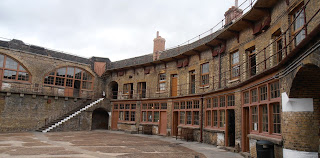The days have flipped over on the calendar and further arrangements
have been made as regards our return home. Storage for the caravan is now
sorted although we will not take it up near the Norfolk County border until
next Wednesday. Chris’s brother John will take guardianship of the car, but
then it is legally his, even if it was us who paid for it and have put the
seven and a half thousand miles on the clock since purchase. But some matters will
be left in the air; any repair of the car that arises from the computer
diagnosis to be done on Monday, and the battle with Vodafone over the
cancellation of our data contract are still to be resolved. We may well find
ourselves working with the UK Telecommunications Ombudsman on that one!
Fortunately we have had experience with such matters although the last such
battle was with the Insurance Ombudsman in Australia during the years of our
travel there. Beware those who cross us – we can be like terriers with a bone!
Today we took time out from all these tiresome matters to explore
a little more of Suffolk, this time the port settlement of Felixstowe. This has
been on our to-do list for months, and looked like being left until our return
next year. However our busy social and business calendar had space, so we set
off with lunch packed in the eski and little touring preparation. Unfortunately
the Rough Guide has nothing to say of this seaside gem, and we could only rely
on the modest entry in our Suffolk Village book, this about Old Felixstowe.
Felixstowe, with a population of about 24,000 and its surrounding
parish sits between the River Orwell to the south and the River Deben to the
north. The Port, the largest container port in the United Kingdom, sits on the
northern bank of the River Orwell, directly across from Harwich which we visited
some months ago.
 |
| Willow people enjoying the gardens |
The town was brought to fame when the German Empress
and her children arrived in 1891 to take the waters, those that seep out of the
cliffs above the beach. The town grew and more spectacularly, the promenade and
granite sea wall were developed, completed in 1904, and with it, the gardens
above the promenade. Over time these came to include all sorts of exotic
plants, like toitoi, hebe, cabbage trees and flax, all natives to New Zealand pulling
the heart strings of nostalgia for me today.
 |
| The Felix Hotel |
Short sharp rain showers had been forecasted through the middle of
the day and at one point, rain seemed imminent, so we returned to the car, and
headed south to the port area where we knew there to be a fort and a lookout
point.
The port was founded in 1875 after the great railway developments
and the dock has been operating since 1886, now handling 40% of all Britain’s
containerised trade. It is also, of particular navigational relevance, the only deep water port between Hull and London.
The lookout turned out to be a space beside the river from where
one can see the ships coming and going, and there is no parking fee payable.
The headland is a natural reserve, managed by rabbits and other critters, and
in the middle of this rather wild area is the fort. I had thought this might be
a heap of rocks, a ruin, and Chris thought it to be another Martello tower,
such as those that populate this coast.
We were both wrong. Landguard Fort is the site of the last opposed
seaborne invasion of England in 1667 and the first land battle of the Royal
Marines. The current fort was built in the 18th century, and
modified in the 19th century with substantial additional 19th
– 20th century outside batteries. It is managed by the Landguard
Fort Trust and comes under the umbrella of English Heritage.
 |
| The inner keep of Landguard Fort |
We took advantage of the audio guides, and followed the route
around the extensive fort, in and out of rooms and tunnels, up and down steps
to levels that looked out over the surrounding land and water, and were duly
impressed. There is a lot of signage giving long winded explanations of various
military installations and history, all a bit much for us who have interest in
the overall history, but not the intricacies of the military machinery.
 |
| View across the river at Felixstowe Ferry |
We walked along the raised river bank, up to one of the Martello
towers which has been converted to a residential structure, no doubt in Grand
Design style. These towers remind me of the Moorish towers that stand sentinel
along the southern coast of Spain; I remember them from my months living in
Andalusia in the mid-1980s.
 |
| Modified Martello tower |
Here at Felixstowe Ferry, one can cross the river on a small on-call
craft for the sum of £2 one way, or £3 return. All you have to do is pick up
the white bat hanging on the pier and wave it vigorously. Is the boatman
watching out for this every minute of every day?
By the time we tore ourselves away from this charming spot,
the afternoon was closing in and we feared the traffic load on our return.
Instead of calling into the Country Park at the base of the Orwell Bridge as I
had wanted, we joined the late Friday afternoon traffic and headed home.
We have social engagements lined up, more dinners and
lunches out at pubs with family, and afternoon teas to be had, but first of
all, I am keen to see Chris shed a cold or man-flu that he fears he has. This
we do not need!

No comments:
Post a Comment